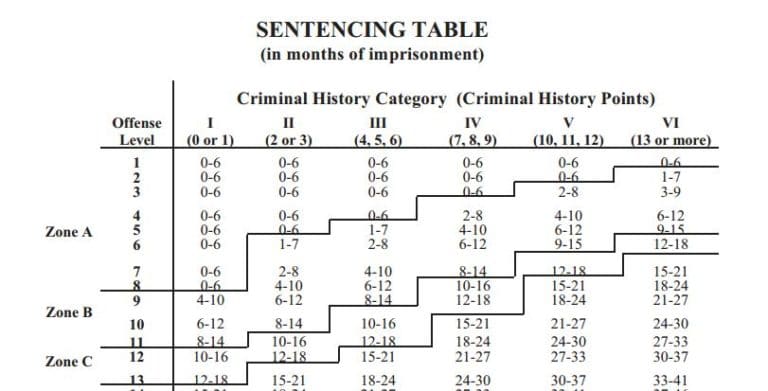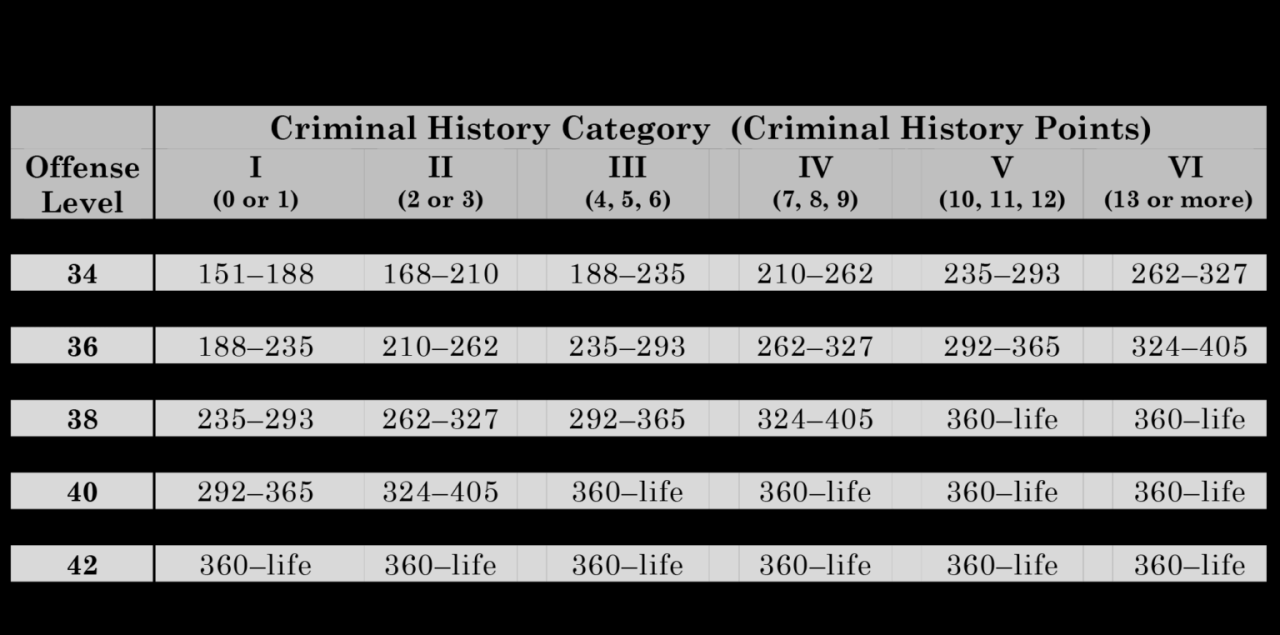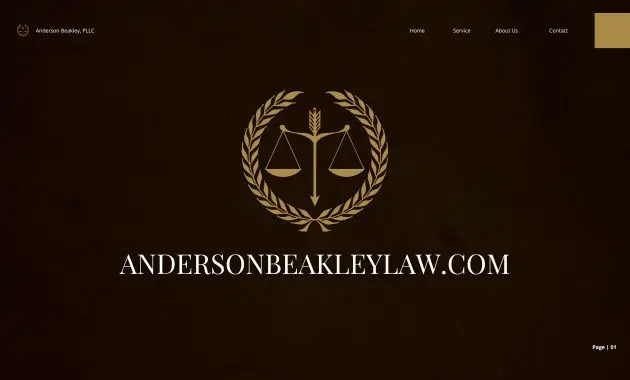Criminal sentencing guidelines, a cornerstone of the American justice system, aim to ensure fairness and consistency in punishments for criminal offenses. They provide a structured framework for judges to determine appropriate sentences, balancing the gravity of the crime with the individual circumstances of the offender.
Since their inception, sentencing guidelines have been the subject of ongoing debate, with proponents advocating for their ability to reduce bias and promote uniformity, while critics highlight concerns about inflexibility and potential for unintended consequences. This exploration delves into the history, purpose, structure, and impact of criminal sentencing guidelines, shedding light on their complexities and evolving role in the pursuit of justice.
Criticisms and Challenges of Criminal Sentencing Guidelines
Criminal sentencing guidelines, despite their aims to ensure fairness and consistency in sentencing, have faced significant criticism and challenges. These criticisms raise crucial questions about the effectiveness and fairness of these guidelines in practice.
Also Read
Sentencing Disparities and Racial Bias
Sentencing guidelines have been criticized for potentially exacerbating existing sentencing disparities, particularly along racial lines. This concern arises from the potential for implicit bias in the application of guidelines and the lack of adequate safeguards to address this issue.
- Implicit Bias in Guideline Application: Research suggests that implicit bias can influence decision-making, even among individuals who believe they are objective. This bias can manifest in the application of sentencing guidelines, leading to disproportionate sentencing outcomes for certain racial groups.
- Lack of Adequate Safeguards: Critics argue that sentencing guidelines often lack sufficient safeguards to address potential racial bias. For instance, guidelines may not adequately account for factors such as socioeconomic disparities, which can disproportionately affect certain racial groups.
For example, studies have shown that individuals of color are more likely to be sentenced to harsher punishments for similar offenses compared to their white counterparts, even after controlling for factors like criminal history. This disparity suggests that implicit bias may be influencing sentencing decisions.
Balancing Individual Circumstances with Guideline Mandates
A fundamental challenge in implementing sentencing guidelines is the balancing act between adhering to the guidelines’ mandates and considering the unique circumstances of each individual case. This tension can lead to criticisms of inflexibility and a lack of individualized justice.
- Inflexibility of Guidelines: Sentencing guidelines, by their nature, impose a degree of rigidity. Critics argue that this inflexibility can prevent judges from considering mitigating factors and individual circumstances that may warrant a more lenient sentence.
- Lack of Individualized Justice: The focus on guidelines can sometimes overshadow the need for individualized justice. Critics argue that guidelines can fail to adequately account for factors such as remorse, rehabilitation efforts, and the unique circumstances surrounding the offense.
For instance, a guideline might mandate a specific sentence for a particular offense, even if the offender has a history of good behavior, strong remorse, and a low risk of recidivism. In such cases, the guideline’s inflexibility may lead to a sentence that is disproportionate to the individual’s circumstances.
Reform and Future Directions in Criminal Sentencing Guidelines

Criminal sentencing guidelines have undergone significant evolution since their inception, with ongoing debates and reforms shaping their application and impact. The need for fairness, consistency, and proportionality in sentencing has driven the development of these guidelines, yet challenges remain. This section examines current trends in sentencing guideline reform, analyzes arguments for and against their use, and explores potential future directions.
Trends in Sentencing Guideline Reform
Reform efforts in criminal sentencing guidelines reflect evolving perspectives on the goals of punishment, the role of discretion, and the impact of guidelines on sentencing outcomes. Several key trends are emerging:
- Increased Focus on Individualized Sentencing: Reform initiatives are emphasizing the need to consider individual circumstances, such as mitigating factors, criminal history, and rehabilitation potential, when determining sentences. This shift aims to reduce the rigidity of guidelines and allow judges greater flexibility to tailor sentences to individual cases. For instance, some jurisdictions are adopting “sentencing ranges” instead of fixed guidelines, providing judges with a broader spectrum of options within which to impose sentences.
- Emphasis on Alternatives to Incarceration: Recognizing the limitations and potential harms of incarceration, reform efforts are promoting alternatives to prison, such as community corrections, drug treatment programs, and restorative justice initiatives. This trend seeks to reduce prison populations and promote rehabilitation while addressing public safety concerns.
- Greater Transparency and Accountability: There is growing recognition of the importance of transparency and accountability in sentencing. Reform efforts are aimed at ensuring that sentencing decisions are made in a fair and impartial manner, with clear criteria and justifications for the sentences imposed. This includes enhancing public access to sentencing data and requiring judges to provide detailed explanations for their sentencing decisions.
- Addressing Racial and Ethnic Disparities: Sentencing guidelines have been criticized for perpetuating racial and ethnic disparities in sentencing outcomes. Reform efforts are seeking to address these disparities by examining and adjusting guidelines to ensure fairness and equity in sentencing practices. This may involve revisiting the scoring systems used in guidelines, analyzing the impact of different guideline provisions on different racial and ethnic groups, and implementing strategies to mitigate bias.
Arguments for and Against the Use of Sentencing Guidelines
The use of sentencing guidelines has been a subject of ongoing debate, with proponents and opponents raising various arguments:
Arguments in Favor of Sentencing Guidelines
- Increased Consistency and Fairness: Proponents argue that sentencing guidelines promote consistency and fairness by providing a structured framework for sentencing decisions. This reduces the potential for arbitrary and discriminatory sentencing practices based on personal biases or judicial whims. For example, guidelines can help ensure that similar offenses are treated similarly, regardless of the judge or the defendant’s background.
- Reduced Sentencing Disparity: Sentencing guidelines aim to reduce sentencing disparity, which refers to the variation in sentences imposed for similar offenses. By providing clear criteria for sentencing, guidelines can help minimize the impact of extraneous factors on sentencing decisions, leading to more consistent outcomes. Studies have shown that jurisdictions with sentencing guidelines have lower levels of sentencing disparity compared to those without.
- Enhanced Transparency and Accountability: Guidelines can enhance transparency and accountability in sentencing by providing a clear and publicly accessible framework for sentencing decisions. This allows for greater public understanding of how sentences are determined and can facilitate public scrutiny of sentencing practices.
- Improved Public Safety: Proponents argue that sentencing guidelines can contribute to improved public safety by ensuring that serious offenders receive appropriate sentences, deterring crime, and promoting public confidence in the criminal justice system. For example, guidelines can ensure that violent offenders are incarcerated for a sufficient period to protect the public.
Arguments Against the Use of Sentencing Guidelines
- Lack of Flexibility and Individualization: Critics argue that sentencing guidelines can be too rigid and inflexible, failing to account for the unique circumstances of individual cases. This can lead to unjust outcomes where defendants with mitigating factors receive sentences that are too harsh, or where defendants with aggravating factors receive sentences that are too lenient.
- Potential for Over-Sentencing: Guidelines can contribute to over-sentencing by promoting a focus on punishment rather than rehabilitation. This can lead to lengthy prison sentences that are disproportionate to the offense and that fail to address the underlying causes of criminal behavior.
- Unintended Consequences: Critics argue that sentencing guidelines can have unintended consequences, such as encouraging prosecutors to charge defendants with more serious offenses to secure longer sentences or leading to plea bargains that result in defendants pleading guilty to offenses they did not commit. This can undermine the integrity of the criminal justice system.
- Lack of Empirical Support: Some critics argue that there is insufficient empirical evidence to support the claim that sentencing guidelines actually reduce sentencing disparity or improve public safety. They point to studies that have shown mixed results regarding the effectiveness of guidelines in achieving these goals.
Potential Future Directions for Criminal Sentencing Guidelines
The future of criminal sentencing guidelines is likely to involve a continued evolution and adaptation in response to emerging challenges and evolving perspectives on the goals of punishment. Several potential directions for future reform include:
- Greater Emphasis on Rehabilitation and Restorative Justice: Future guidelines may incorporate a stronger emphasis on rehabilitation and restorative justice principles. This could involve providing judges with greater discretion to impose sentences that focus on addressing the underlying causes of criminal behavior and promoting the offender’s reintegration into society. For example, guidelines could encourage the use of drug treatment programs, mental health services, and restorative justice initiatives as alternatives to incarceration.
- Increased Use of Technology and Data Analytics: Advances in technology and data analytics are likely to play a growing role in criminal sentencing. This could involve the development of algorithms and predictive models to assess risk and recidivism, inform sentencing decisions, and monitor the effectiveness of different sentencing practices. However, it is crucial to ensure that the use of technology is ethical and does not perpetuate existing biases.
- Greater Collaboration and Coordination: Future reform efforts may involve greater collaboration and coordination between different stakeholders in the criminal justice system, including judges, prosecutors, defense attorneys, probation officers, and community organizations. This could involve the development of shared guidelines and practices that promote a more unified and effective approach to sentencing.
- Increased Public Engagement and Transparency: Future guidelines may be developed with greater public engagement and transparency. This could involve the creation of public forums and advisory committees to gather input from stakeholders, including victims, offenders, and community members, on sentencing policies. Increased transparency could also involve making sentencing data more readily available to the public, allowing for greater scrutiny and accountability.
Impact of Criminal Sentencing Guidelines on Sentencing Outcomes
Sentencing guidelines have significantly impacted sentencing outcomes in various jurisdictions. These guidelines, designed to promote fairness and consistency in sentencing, have led to notable changes in sentencing practices, affecting both the severity and length of sentences imposed. Analyzing the impact of these guidelines on sentencing outcomes requires examining trends before and after their implementation and evaluating their effectiveness in achieving intended goals.
Sentencing Trends Before and After Implementation of Guidelines, Criminal sentencing guidelines
The implementation of sentencing guidelines has resulted in measurable changes in sentencing trends. Studies have shown that after the introduction of guidelines, sentences have generally become more determinate and less discretionary. This shift can be attributed to the guidelines’ structured approach, which provides clear parameters for judges to follow when imposing sentences.
- Increased Sentencing Severity: In many jurisdictions, the implementation of sentencing guidelines has led to an increase in sentencing severity. This is often attributed to the guidelines’ emphasis on mandatory minimum sentences for certain offenses, which limits judicial discretion and often results in longer prison terms. For example, the implementation of “three strikes” laws in the United States, which mandate life sentences for repeat offenders convicted of certain felonies, has been linked to a significant increase in prison populations.
- Reduced Sentencing Disparity: Sentencing guidelines have been credited with reducing sentencing disparity, the unevenness in sentences imposed for similar offenses. By providing a standardized framework for sentencing, guidelines aim to minimize the influence of factors such as the judge’s personal biases or the defendant’s socioeconomic background. However, the extent to which guidelines have actually reduced disparity remains a subject of debate. Some studies have found that while guidelines have reduced disparities between judges, disparities between jurisdictions and for different racial groups persist.
Sentencing Guidelines and the Role of Judicial Discretion: Criminal Sentencing Guidelines

Sentencing guidelines are designed to promote consistency and fairness in sentencing, but they also acknowledge the need for judicial discretion to account for the unique circumstances of each case. This section explores the delicate balance between guideline mandates and judicial discretion, examining the potential for abuse or misuse of discretion in applying guidelines.
The Role of Judicial Discretion in Sentencing under Guidelines
Sentencing guidelines provide a framework for judges to determine appropriate sentences, but they do not eliminate judicial discretion entirely. Judges are expected to consider the specific facts of each case, the offender’s background, and the nature of the crime before imposing a sentence. This discretion allows judges to tailor sentences to individual circumstances, ensuring that punishment is proportionate to the offense and the offender’s culpability.
Balancing Guideline Mandates and Judicial Discretion
Sentencing guidelines aim to reduce disparities in sentencing by providing a structured approach, but they also recognize the need for judges to exercise discretion in individual cases. The balance between guideline mandates and judicial discretion is crucial for achieving both consistency and fairness in sentencing.
Sentencing guidelines provide a framework for judges to determine appropriate sentences, but they do not eliminate judicial discretion entirely.
Judges are expected to follow the guidelines, but they also have the authority to deviate from them when justified by mitigating or aggravating circumstances. For example, a judge might impose a sentence below the guideline range if the offender has a history of rehabilitation or has shown remorse for their actions. Conversely, a judge might impose a sentence above the guideline range if the crime was particularly heinous or the offender poses a significant risk to public safety.
Potential for Abuse or Misuse of Discretion in Applying Guidelines
While judicial discretion is essential for achieving fairness in sentencing, it also presents the potential for abuse or misuse. Judges may be influenced by personal biases, political pressures, or other factors that could lead to inconsistent or unfair sentencing decisions.
The balance between guideline mandates and judicial discretion is crucial for achieving both consistency and fairness in sentencing.
For example, a judge might be more lenient towards offenders from a particular socioeconomic background or who share their political views. Conversely, a judge might be more harsh towards offenders from a different racial or ethnic group. These biases can lead to disparities in sentencing, undermining the goal of fairness and equality.
Examples of Potential for Abuse or Misuse of Discretion
* A judge might impose a harsher sentence on an offender who is a member of a particular gang, even if the crime is similar to those committed by other offenders who are not gang members.
* A judge might impose a more lenient sentence on an offender who is a close friend or family member of a powerful political figure.
* A judge might impose a more lenient sentence on an offender who is from a wealthy background, even if the crime is serious.
It is important to note that these are just examples, and there is no evidence to suggest that all judges are biased or that all sentencing decisions are unfair. However, the potential for abuse or misuse of discretion is a real concern, and it is important to have safeguards in place to ensure that all offenders are treated fairly.
The implementation of criminal sentencing guidelines has significantly shaped the landscape of criminal justice in the United States. While they have contributed to greater consistency and transparency in sentencing, their application raises important questions about balancing individual circumstances with guideline mandates, ensuring fairness across diverse populations, and promoting effective rehabilitation. As we navigate the complexities of criminal justice, the ongoing evaluation and reform of sentencing guidelines remain critical to achieving a system that is both just and effective.
Criminal sentencing guidelines aim to ensure fairness and consistency in punishments for crimes. However, these guidelines can become more complex when dealing with cross-border offenses, as different jurisdictions may have varying legal frameworks. Understanding the nuances of cross-border business law is crucial for navigating these complexities, especially for companies operating internationally. This knowledge can help businesses comply with international regulations and mitigate potential legal risks related to criminal sentencing guidelines.



